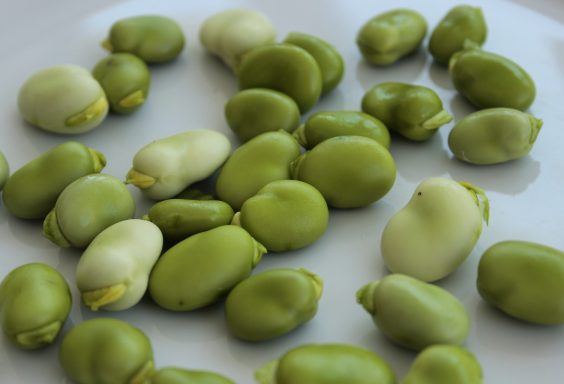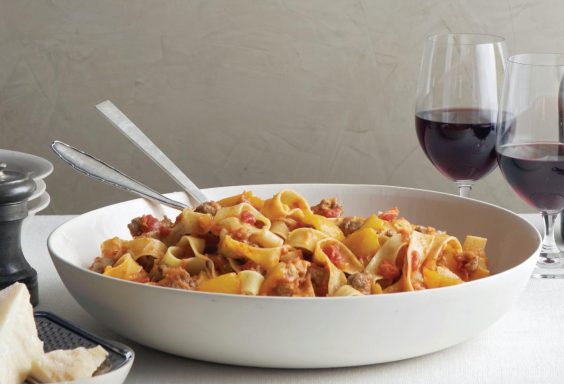 When one thinks of a sauce for pasta, most people think of the classic Bolognese. It is the quintessential comfort food, and one of our family’s favorites. Although true Bolognese is time consuming to make, it freezes well so we often make large batches that we divide into meal-sized containers that can be ready anytime.
When one thinks of a sauce for pasta, most people think of the classic Bolognese. It is the quintessential comfort food, and one of our family’s favorites. Although true Bolognese is time consuming to make, it freezes well so we often make large batches that we divide into meal-sized containers that can be ready anytime.
Classic Bolognese is one of those sauces with many versions, and most Italian cooks believe that theirs is the only truly authentic preparation. Most food historians agree that the sauce was created in the city from which it is named, Bologna, the capital of the region where my husband’s family is from. People from that area are so serious about “their” recipe that they have trademarked the name and made January 17th “Ragù alla Bolognese” day. The Accademia Italiana della Cucina registered their recipe for the sauce in 1982 as the one authentic version. It organized an international Bolognese day in 2010 during which 450 chefs cooked the sauce; however, true to Italian custom, most used their own “authentic” recipes and not the trademarked registered one.
The first Italian immigrants to the United States hoped to find a land of milk and honey with streets paved of gold. In the late 1800’s southern Italy was very poor and the American railroad barons, realizing that Southern Italians could be a source of labor, produced films showing a picturesque America that was welcoming and where hard-working people could achieve great wealth. Of course, the reality was a bit different. The Italians who moved to the US were lucky to find back braking labor and slave wages. In addition, they were considered the lowest of the low in the communities they moved into. As it was in Italy, their cuisine was “la cucina povera” the food of poverty and included little meat. However, as years went by and through hard work and perseverance, many children of those first Italian immigrants were able to succeed. They craved the dishes of the wealthy Italians that their parents had told them about. However, in most cases, neither they nor their parents had ever experienced the lightness of true lasagna or the delicacy of a risotto. The Italian American community had to create their own variations of the dishes and since, in the US, bigger is better they came up with the gigantic meatball on a dish of spaghetti. Something that is not seen in Italy. So American Italian cuisine developed and should be celebrated as its own creation. Baked Ziti, deep-dish pizza, and Italian dressing are only a few of the recipes in the vast repertoire. Bolognese sauce isn’t one of them.
Meat ragu in America tends to be very heavy and the pasta almost drowns in the sauce. In classic Bolognese, the sauce and the pasta are in symbiosis and enhance each other. This is one of those sauces that is best with homemade egg pasta, and is a delicacy that, in my family, we could eat weekly.
Bolognese Meat Sauce
(From How to Cook Italian by Giuliano Hazan)
Preparation time: 25 minutes
Total time from start to finish: 3 1/2 hours
Makes enough for 1 pound dried pasta, or 3 eggs of homemade pasta
1/2 small yellow onion
1 small carrot
1 stalk celery
3 tablespoons butter
2 tablespoons extra virgin olive oil
12 ounces ground beef chuck
salt
1 cup dry white wine
1/2 cup whole milk
1/8 teaspoon nutmeg
2 cups canned whole peeled tomatoes with their juice
1. Peel and finely chop the onion. Peel the carrot and celery and cut into 1/4” dice to get 1/4 cup each. Put the onion, carrot, celery, butter, and olive oil in a heavy bottomed sauce pot and place over medium high heat. Sauté, stirring occasionally, until the vegetables have lightly browned, about 10 minutes.
2. Add the ground beef and break it up with a wooden spoon. Season with salt and continue stirring until the meat has lost its raw red color.
3. Add the wine and cook, stirring occasionally, until it has almost completely evaporated. Add the milk and the nutmeg and cook, stirring occasionally, until the milk has mostly evaporated.
4. Coarsely chop the tomatoes and add them to the pot. Season with salt. Once the tomatoes have started bubbling, turn the heat down very low so that the sauce is barely simmering. Cook uncovered for 3 hours stirring occasionally. If all the liquid evaporates before the cooking time is up, add 1/2 cup of water as needed. After 3 hours, make sure all the liquid has evaporated before you remove the sauce from the heat.
Note: You can prepare the sauce ahead of time and refrigerate it for 2-3 days or freeze it up to 2 months.






15 comments
Everyone should have a good bolognese sauce in there repertoire and this one looks like one I need to try. Interesting the milk and nutmeg – I can’t wait to try it!
[…] This post was mentioned on Twitter by Gail Dosik, Lael Hazan. Lael Hazan said: @Giulianohazan's recipe for Classic Bolognese Meat Sauce the perfect comfort food http://t.co/ChRkS6s […]
I’ve always loved this scrumptious sauce, but it is only since a few years that I have discovered that one must add milk to it… It is a great addition. Now I always make sure to prepare my Bolognese in the traditional way.
Cheers,
Rosa
[…] Classic Bolognese Meat Sauce […]
Thank you so much for this recipe! I have been looking for an authentic bolognese sauce for awhile! Italian immigrants have enriched our cuisine in so many ways. But my kids were disappointed at the Pizza in Naples. They were expecting a thick & greasy pizza with lots of cheese, which they are used to here. But what they got at Da Michele in Naples was a very this slice with hardly any cheese. But now they love the authentic woodburning oven, thin pizza! 🙂
Great post – I was interested in the reason American Italian cooking is so different from the original Italian dishes. It makes perfect sense. Now I understand the cultural conflicts better in the movie Big Night – when “sometimes the spahetti wants to be alone!”
The milk really makes a difference – I’ve adopted it whenever I cook minced beef now, even for the classic English cottage pie – it just makes the mince so much more tender. So now it’s an Italo -English recipe!
This is lovely, it’s great to see such an authentic recipe. I’m seeing my brother soon and he swears he was Italian in a past life: I’ll have to make this! 🙂
Nothing like a classic Bolognese! Thank you for this authentic recipe.
I’m so glad you posted this recipe. 🙂 I did not grow up making Italian food so it’s always been a bit daunting to me. I love the sounds of this sauce and had NO idea it would include milk and nutmeg. How marvelous. 🙂
It took me years to come up with a bolognese ragu that I was happy with but when it happened, it was worth the wait. I know I would like your version, too. I think milk is essential to add some creaminess to the sauce. Now I wish I had a batch stored in the freezer!
This looks absolutely marvellous! I’m had a spaghetti bolognese tonight too! 🙂
What I wouldn’t give to be in Bologna on January 17th! I love your stories and love thinking about the evolution of something so classic yet so evolved. I also heard that “real” Bolognese sauce had no meat? I have never been really good at making a wonderful, full-flavored ragu’ for some reason so I must try your version.
[…] This post was mentioned on Twitter by CP, Gary Ransome. Gary Ransome said: RT @culinaryprep: Pasta: Italian Meat Sauce: http://bit.ly/hjNqYy […]
Lovely sauce that screams warmth and comfort. I will make this with my next pasta dinner.
I bet this is delicious! I just started making a basic pasta sauce– this would be a nice upgrade for me to try.
[…] Classic Bolognese Meat Sauce […]
I avoid alcohol because of dietary restrictions. What can i replace the white wine with? Also, could you replace the beef with chicken? Thanks!
I’ll be trying this out tomorrow! I was going to make it today and had to pace myself and put it off because of my recent addiction to cooking. Thanks for the background information, it’s really fascinating!
This is a fabulous recipe! I used Marsala wine, and I also added fennel seeds and sweet basil, a bayleaf, garlic, and a little sugar to cut the acidity of the tomatoes. Tastes like Italy. Thanks!